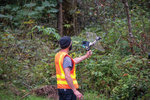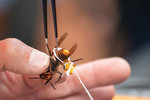

Using lessons learned from the first Asian giant hornet tracking attempt last week, researchers inched closer to success with a second attempt at tracking a live hornet on October 7.
The attempt ultimately failed after researchers lost the radio signal but it was not without triumph, said Sven Spichiger, Washington State Department of Agriculture (WSDA) managing entomologist during an October 12 news conference.
“Everything is progressing as much as possible,” Spichiger said. “I’m pretty hopeful we’ll have a nest and perform an eradication”
Urgency comes as the hornets enter the ‘slaughter’ phase, where the hornets can destroy an entire bee colony to feed their young. By the end of October, hornets will start mating and venture out to create new colonies by next spring.
The live hornet was caught on October 5 at the same east Blaine location as the first tracking attempt, near Burk Road. Agency officials tried tracking the hornet the next day but had to start over on October 7 due to a technology malfunction on the tracking chip.
Scientists waited until fog cleared after noon to ensure they could see the hornet as it took off. They tied a tracking device onto the hornet’s abdomen with dental floss, instead of glue, which didn’t dry fast enough during the first tracking attempt and rendered that hornet immobile.
European counterparts, who use a similar device to track the Asian hornet, a different species, suggested the Washington scientists place the hornet on a higher surface for flight. The hornet launched off an apple tree and landed on a few nearby trees before landing near dense Himalayan blackberry bushes. The scientists then lost track of the hornet when it quickly flew into trees.
Vikram Iyer, a Ph.D. student at the University of Washington, contacted WSDA early this year about adapting a bug camera he made for beetles to track the invasive hornet.
The Bluetooth chip sends out a radio signal twice per second that allows people to track the chip through an app on their phone. The signal is directed about 30 feet from the radio tag in a forested area and up to a few hundred feet in a field, Iyer said.
“This is the same sort of approach that’s used in traditional wildlife tracking for large animals but this is struck down to a really small size,” he said during the news conference.
Staff were able to get an initial flight direction and talk to surrounding property owners who gave eyewitness sightings from the week prior and earlier in the summer, Spichiger said.
In the next few weeks, the agency will receive new radio tags with distances that reach farther with a stronger signal, Spichiger said. The tags aren’t kept in stock because of their short shelf life, he added.
The second tracking attempt came as the agency also received reports of two new sightings on October 9: A worker hornet trapped a mile south of the first Blaine sighting in December 2019 and a hornet trapped by Canadian authorities in Langley, B.C., just north of the border near the east Blaine sightings.
The two U.S. hornet findings on October 5 and October 9 brings the total number of confirmed specimens in Whatcom County to 18.
Spichiger said he is confident the agency will eradicate the east Blaine nest before the end of the month, but is worried by the lack of sightings near the suspected Birch Bay nest. A third nest is probable, he said, especially after the October 9 hornet trapped within Blaine city limits.
“We expected we’d see far worse than this and we’re really only focused on two or three areas in Whatcom County,” said Spichiger, who once feared the invasive species would have spread across western Washington by now. “But it looks like we’re concentrated in one area, which really gives us a fighting chance.”
Once the east Blaine nest is located, WSDA will perform an early morning eradication. The agency staff will vacuum hundreds of hornets out of the underground nest and then inject a tube with carbon dioxide to kill any remaining.
“We’re hurrying as much as we can but there’s a lot of ground for us to cover,” Spichiger said. “We will continue our efforts until we win.”
To report an Asian giant hornet sighting, visit bit.ly/34akL4H. People without internet can also call the hotline, 800/443-6684 but this will take longer for WSDA staff to respond due to a heavy call volume. Beekeepers with hives under attack are urged to call the emergency line, 360/902-1880. For more information, visit agr.wa.gov/hornets.
Comments
No comments on this item Please log in to comment by clicking here